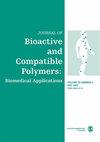胶原、黑皮、壳聚糖电纺生物纳米复合支架在皮肤组织工程中的应用
IF 2.1
4区 生物学
Q3 BIOTECHNOLOGY & APPLIED MICROBIOLOGY
引用次数: 1
摘要
新型复杂的组织工程研究重点是制备具有不同形态的纳米复合材料以实现组织的快速再生。在这种情况下,利用纳米技术与生物基材料的结合已经引起了研究人员的兴趣。本研究旨在通过在聚氯乙烯(PVA)层上以不同比例进行双层绿色静电纺丝,制备胶原蛋白(Col)、黑草(Ns)和壳聚糖(Cs)的复合生物纳米支架,用于组织再生。采用场发射电子显微镜(FE-SEM)、傅里叶变换红外光谱(FTIR)、水分管理性能、拉伸性能、抗菌活性和伤口愈合评价等方法对制备的杂化生物纳米支架的不同性能进行研究。结果表明:含Col(50%)、Ns(25%)、Cs(25%)的样品纤维形成良好,平均直径为381±22 nm;这种生物纳米支架的孔隙率为78±6.9%,具有快速吸收-缓慢干燥的特性,可提供潮湿的环境。对金黄色葡萄球菌和大肠杆菌的抑菌带(ZOI)分别为10±1.3 mm和8±0.9 mm,具有足够的抑菌作用。伤口愈合评估表明,84±3.8%的伤口愈合发生在10天内,比商业绷带的持续时间快(1.5倍)。所有的研究结果表明,生物纳米支架在皮肤组织工程中可能是有用的。本文章由计算机程序翻译,如有差异,请以英文原文为准。
Electrospun bio-nano hybrid scaffold from collagen, Nigella sativa, and chitosan for skin tissue engineering application
The new sophisticated tissue engineering focused on producing nanocomposite with different morphologies for rapid tissue regeneration. In this case, utilizing nanotechnology with the incorporation of bio-based materials have achieved the interest of researchers. This research aims at developing hybrid bio-nano scaffold with collagen (Col), Nigella sativa (Ns), and chitosan (Cs) by a bi-layered green electrospinning on polyvinyl chloride (PVA) layer in a different ratio for tissue regeneration. Field emission electron microscopy (FE-SEM), fourier transform infrared spectroscopy (FTIR), moisture management properties, tensile properties, antibacterial activity, and wound healing assessment of the fabricated hybrid bio-nano scaffolds were employed to investigate the different properties of hybrid bio-nano scaffolds. The results exhibit that the sample with Col (50%) and Ns (25%), Cs (25%) has good fiber formation with a mean diameter of 381 ± 22 nm. This bio-nano scaffold has a porosity of 78 ± 6.9% and a fast absorbing-slow drying nature for providing a moist environment. The antibacterial zones of inhibition (ZOI) against Staphylococcus aureus and Escherichia coli were 10 ± 1.3 and 8 ± 0.9 mm respectively, and appeared to be adequate to inhibit bacterial action. The wound healing assessment states that 84 ± 3.8% of wound closure occurs in just 10 days, which is quicker (1.5 times) than the duration of a commercial bandage. All of the findings suggest that the bio-nano scaffold could be useful for skin tissue engineering.
求助全文
通过发布文献求助,成功后即可免费获取论文全文。
去求助
来源期刊

Journal of Bioactive and Compatible Polymers
工程技术-材料科学:生物材料
CiteScore
3.50
自引率
0.00%
发文量
27
审稿时长
2 months
期刊介绍:
The use and importance of biomedical polymers, especially in pharmacology, is growing rapidly. The Journal of Bioactive and Compatible Polymers is a fully peer-reviewed scholarly journal that provides biomedical polymer scientists and researchers with new information on important advances in this field. Examples of specific areas of interest to the journal include: polymeric drugs and drug design; polymeric functionalization and structures related to biological activity or compatibility; natural polymer modification to achieve specific biological activity or compatibility; enzyme modelling by polymers; membranes for biological use; liposome stabilization and cell modeling. This journal is a member of the Committee on Publication Ethics (COPE).
 求助内容:
求助内容: 应助结果提醒方式:
应助结果提醒方式:


